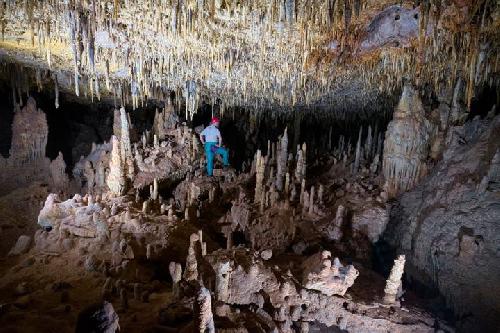Rather than the treeless, limestone expanse we know today, the Plain was flush with gum and eucalyptus trees, banksias and other flowering plants now confined to Australia's east coast.
Scientists at the University of Melbourne used new techniques to date fossilised pollen and reveal the Plain's 'big wet' - a dramatic transformation in climate that occurred around five million years ago.
The finding sheds new light on the environmental history of the Nullarbor, a former seabed that was lifted above the sea 14 million years ago.

"The Nullarbor region had a relatively dry climate until five million years ago, but then the vegetation suddenly changed," said palaeoclimate scientist Dr Kale Sniderman.
"In just 100,000 years, it became a forest of gums and banksias, which suggests a rainfall of two or up to four times higher than today."
The Nullarbor Plain - an area covering 200,000 km2 bordering the Great Australian Bight between South and Western Australia - is today a treeless saltbush shrubland and the largest exposure of limestone in the world.
It receives an average of 250 mm of rain each year, but before five million years ago the rainfall was approximately 480mm, Dr Sniderman said.
During the 'big wet' between five and 3.5 million years ago precipitation rose to an estimated 1220mm.
Investigating the climate history of Australia's desert regions is traditionally difficult for scientists, given the scarcity of fossils and the difficulty in accurately dating them.
This research successfully employed new methods of dating and analysis, by focusing on the dating of Nullarbor speleothems (stalagmites, stalactites and flowstones).
Until now, it has been impossible to date speleothems more than about 500,000 years old.
Paper co-author Professor Jon Woodhead, also from the University's School of Earth Sciences, has spent the past decade perfecting methods of dating these old samples, and can now date speleothems of any age.
Dr Sniderman was then able to dissolve Professor Woodhead's dated samples to examine ancient pollen trapped within them.
"Most didn't contain any pollen, which isn't surprising since many speleothems grew in caves that had no openings to the surface," Dr Sniderman said.
"But some did contain fossil pollen, which revealed the nature of the vegetation growing at those times.
"Through that we've been able to develop a new understanding of the history of the Nullarbor's climate."
Prof Woodhead said the research showed there was much more to the Nullarbor than its iconic landform.
"It is also home to a scientific treasure trove of palaeoclimate information that has potential global significance," he said.
The research has been published in the latest edition of the journal, Proceedings of National Academy of Sciences of the United States of America.




Comments